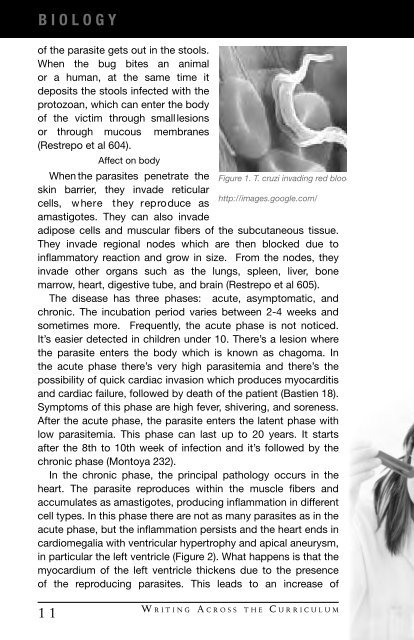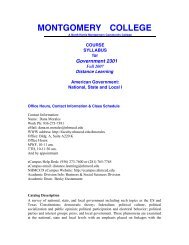2008 - Communication Across the Curriculum (CAC)
2008 - Communication Across the Curriculum (CAC)
2008 - Communication Across the Curriculum (CAC)
Create successful ePaper yourself
Turn your PDF publications into a flip-book with our unique Google optimized e-Paper software.
B i o l o g y<br />
of <strong>the</strong> parasite gets out in <strong>the</strong> stools.<br />
When <strong>the</strong> bug bites an animal<br />
or a human, at <strong>the</strong> same time it<br />
deposits <strong>the</strong> stools infected with <strong>the</strong><br />
protozoan, which can enter <strong>the</strong> body<br />
of <strong>the</strong> victim through small lesions<br />
or through mucous membranes<br />
(Restrepo et al 604).<br />
Affect on body<br />
When <strong>the</strong> parasites penetrate <strong>the</strong> Figure 1. T. cruzi invading red blood cells.<br />
skin barrier, <strong>the</strong>y invade reticular<br />
http://images.google.com/<br />
cells, where <strong>the</strong>y reproduce as<br />
amastigotes. They can also invade<br />
adipose cells and muscular fibers of <strong>the</strong> subcutaneous tissue.<br />
They invade regional nodes which are <strong>the</strong>n blocked due to<br />
inflammatory reaction and grow in size. From <strong>the</strong> nodes, <strong>the</strong>y<br />
invade o<strong>the</strong>r organs such as <strong>the</strong> lungs, spleen, liver, bone<br />
marrow, heart, digestive tube, and brain (Restrepo et al 605).<br />
The disease has three phases: acute, asymptomatic, and<br />
chronic. The incubation period varies between 2-4 weeks and<br />
sometimes more. Frequently, <strong>the</strong> acute phase is not noticed.<br />
It’s easier detected in children under 10. There’s a lesion where<br />
<strong>the</strong> parasite enters <strong>the</strong> body which is known as chagoma. In<br />
<strong>the</strong> acute phase <strong>the</strong>re’s very high parasitemia and <strong>the</strong>re’s <strong>the</strong><br />
possibility of quick cardiac invasion which produces myocarditis<br />
and cardiac failure, followed by death of <strong>the</strong> patient (Bastien 18).<br />
Symptoms of this phase are high fever, shivering, and soreness.<br />
After <strong>the</strong> acute phase, <strong>the</strong> parasite enters <strong>the</strong> latent phase with<br />
low parasitemia. This phase can last up to 20 years. It starts<br />
after <strong>the</strong> 8th to 10th week of infection and it’s followed by <strong>the</strong><br />
chronic phase (Montoya 232).<br />
In <strong>the</strong> chronic phase, <strong>the</strong> principal pathology occurs in <strong>the</strong><br />
heart. The parasite reproduces within <strong>the</strong> muscle fibers and<br />
accumulates as amastigotes, producing inflammation in different<br />
cell types. In this phase <strong>the</strong>re are not as many parasites as in <strong>the</strong><br />
acute phase, but <strong>the</strong> inflammation persists and <strong>the</strong> heart ends in<br />
cardiomegalia with ventricular hypertrophy and apical aneurysm,<br />
in particular <strong>the</strong> left ventricle (Figure 2). What happens is that <strong>the</strong><br />
myocardium of <strong>the</strong> left ventricle thickens due to <strong>the</strong> presence<br />
of <strong>the</strong> reproducing parasites. This leads to an increase of<br />
1 1<br />
W r i t i n g A c r o s s t h e C u r r i c u l u m






